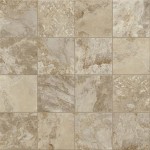Installing floor tile is a great way to add a touch of style and sophistication to your home. Vinyl floor tile is a popular choice among homeowners who want to achieve the look of natural stone, tile, or hardwood on a budget. Installing vinyl floor tile is a relatively simple process, and with the right tools and materials, you can have beautiful, long-lasting floors in no time.
Preparing the Subfloor
Before you begin installing vinyl floor tile, you need to make sure that the subfloor is in good condition. A subfloor is the layer of material that lies beneath the finished floor. It can be made of plywood, concrete, or even a combination of both. You should inspect the subfloor for any cracks, holes, or other damage that could affect the installation. If necessary, you can fill any cracks or holes with a concrete filler, and sand the area to smooth it out. You should also make sure that the subfloor is clean and free of any debris before beginning the installation process.
Gathering the Materials
Before you start installing your vinyl floor tile, you need to make sure you have all the materials and tools you need. You’ll need vinyl floor tiles, adhesive, spacers, and a measuring tape, as well as a saw, trowel, and other tools for cutting and laying the tile. You should also have a good quality sealer on hand to protect your floor from water and other damage.
Laying the Tiles
Once you have all your materials ready, you can begin laying the tile. Start by measuring the area where the tile will be installed, and cut the tiles to fit using a saw. You should use spacers between the tiles to make sure they are even and properly spaced. Once the tiles are in place, use a trowel to spread the adhesive onto the back of each tile. Once the adhesive is in place, press the tile firmly into the subfloor to ensure that it is secure.
Curing the Adhesive
After the tiles are in place, you need to let the adhesive cure before you can walk on the floor. This process can take anywhere from 24 to 48 hours, so it’s important to be patient. During this time, you should cover the floor with a protective covering and avoid walking on it. Once the adhesive is fully cured, you can remove the covering and enjoy your beautiful new floor.
Applying the Sealer
Once the adhesive has cured, you should apply a sealer to the floor. This will help protect the tile from water damage and other wear and tear. Make sure to read the instructions on the sealer carefully, as there may be different instructions for different types of tiles. After the sealer has dried, your floor is finished and ready to use.
Caring for Your Floor
Once your floor has been installed, you need to take proper care of it to ensure that it lasts for years to come. Regular sweeping and mopping will help keep it looking its best. You should also avoid using harsh chemicals or abrasive cleaners, as these can damage the tile. With proper care and maintenance, your vinyl floor tile will look beautiful for years to come.
/cdn.vox-cdn.com/uploads/chorus_image/image/65891755/howto_vinylfloor_05.0.jpg)














Related Posts








